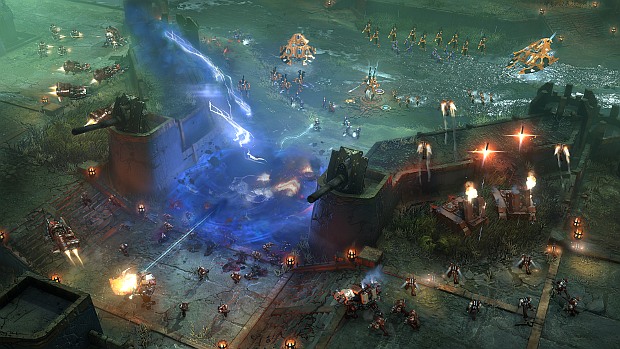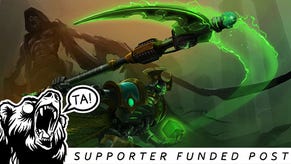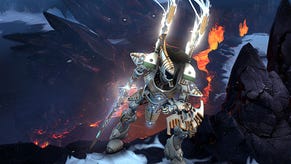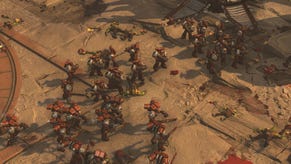Dawn of War 3 is a best-of mashup of Warhammer 40k
Dawn of War has learned from MOBAs
Among the many things that might wake you up in the morning – coffee, cigarettes, aggressive thrash metal – nothing really comes close to being chased by a towering Space Marine Titan, spewing out fire and bullets in a wanton display of horrifying aggression as pitiful Orks scatter and flee. Dawn of War 3’s [official site] invigorating multiplayer is like a shot of adrenaline, blood-pumping, loud and messy.
Based on my time with it, there’s a great deal going on in Relic’s latest foray into the grimdark universe of Warhammer 40K. It’s not entirely unlike attempting to play the previous two Dawn of Wars at the same time, a mashup of each game’s best bits, but with more stuff drawn from both the tabletop games and even other genres.
“We looked at first-person shooters, RPGs, MOBAs and started picking out the things that are distinctive to these game genres and figuring out why they are interesting,” producer Matt Kernachan tells me. “And what did the fans like about the armies from Dawn of War? What did they like about the gameplay from Dawn of War 2? What did we like… what did we think was great or not really enjoy?”
So there’s a collision of ideas. You get your big, Dawn of War-style armies, but they’re now accompanied by hero units, Elites, that are more evocative of Dawn of War 2 and MOBAs, complete with the sort of micro-management wrinkles you might expect. You’ve also got base-building shenanigans and setting up defensive lines, but there’s still this focus on mobility and trying to manage a whole bunch of capture points spread out across the map.
Even before you dive into a battle, there are a few major choices that need to be made. First off, there’s your faction choice, of course, where you’ll pick between the Space Marines, Eldar or Orks. That first decision is going to define how you play, at least for that match. If you’re assaulting a base as Space Marines, for example, you might pummel the area with Whirlwind tanks before jumping in with troops strapped to jetpacks while drop pods fall from the sky, depositing reinforcements. With the Eldar, however, you might want to go for a sneakier strategy, plonking down Webway Portals so your entire army can traverse the map in the blink of an eye, getting right up to the enemy base in a single step.
There’s flexibility within each faction, though. One Ork player, for instance, might favour brute force, turning their Boyz and Nobz into an unstoppable green tide through the power of the Waaagh! Another might prefer subtlety, using shamanistic magic to teleport brutish warriors to key locations. A lot of these strategies are going to be determined by another key decision you make at the start: what Elites are you going to use? These special units come in all manner of shapes and sizes, blessed with a list of special powers that define their roles. You’ve got your tanky heavy-hitters, your nimble DPSers and even some tricky, situational support characters.
“We wanted them to be larger than life,” explains Kernachan. “We wanted them to have names, not like faceless troops, and as soon as they come on the field you’re like ‘Shit, things are going to get real now.’ But we also didn’t want them to feel invulnerable or invincible – they’re something to rally around with their own unique mechanics.”
Elites are considerably more elaborate than regular squads and demand a lot more attention. Farseer Macha, for instance, employs her ‘Singing Spear’ in a bunch of interesting ways that only really shine when you’re micro-managing her. First, she can toss it at enemies, doing direct damage, then she can activate it, generating an AoE pulse that applies a handy debuff. Finally, she can reposition herself and call the spear back to her, damaging any enemies it passes through again. In single-player, these can be devastating abilities, but when playing with a chum, they can create openings or synergise with the abilities of other Elites.
The final pre-battle consideration is what type of battle doctrines, a holdover from Company of Heroes 2, you’ll bring in with you. Some of them are army-wide buffs, while others change the abilities of specific units, and they’re also part of Dawn of War 3’s progression system.
“Each of the Elites has their own doctrines, and there are global army doctrines too,” notes Kernachan. “The Elites get a presence doctrine that provides a bonus just from them being on the field, and there are separate command doctrines as well. With the progression system, you’ll start with the presence doctrine and then after a few levels you’ll gain the ability to use their command doctrine. Further through the tree, you’ll be able to use that Elite doctrine as a global army doctrine, so you don’t even need to deploy that Elite anymore to take advantage of the bonuses.”
It’s a lot to take in... and we haven’t even started the match yet.
For a long time now, Relic’s favoured objective-based battles with an emphasis on capturing victory points, and in Dawn of War 3 the spirit of this system remains, but it’s inside something new. At opposite ends of the map lie two power cores, one for each player or team. They’re essentially the giant mechanical heart of the war machine, and they’re what you’re fighting over. The primary goal of a battle is to protect your core while smashing your enemy’s to bits.
It doesn’t matter how many fights you win, how many resource-generating points you’ve captured or how big your base is – if you leave your core undefended, you’ve had it. They can’t be attacked straight away, however. The cores are protected by incredibly powerful turrets, for one, and a pair of massive shield generators as well. All of them need to be destroyed before hitting that final target. Taking out a power core isn’t something that’s really feasible in one assault when there are all these defences, so it becomes this massive undertaking that spans the entire game.
“We started looking at these sort of gated targets on the battlefield,” says Kernachan. “We wanted to get away from just destroying your enemy’s base or hunting around on the map to find that last victory or resource point. We were influenced from a bunch of places. MOBAs had the towers which are interesting, but we didn’t want to make a MOBA, we wanted to make an RTS. So we came up with this power core system.”
While the power core gets top billing, capturing and holding strategic points dotted around the map remains key to victory. Units can be crammed into capturable shielded areas that replace Dawn of War 2’s cover system, forcing enemies to engage in some melee combat if they want to get past, while other capture points generate the resources you’ll need for the construction of buildings and the recruitment of new troops. There’s one further complication in the form of yet another resource: Elite points.
Each Elite has a cost associated with it and can only be summoned when you’ve generated enough points. If you want to drop the aforementioned Space Marine Titan, Solaria, into a fight, you’ll need to save up, maybe even forgoing the cheaper Elites, leaving you vulnerable during the early stages of a match.
The acquisition of this currency is a major goal for each battle. See, while they generate over time, there are special capture points that increase the rate considerably, but there aren’t many of them. Some maps only have one, equidistant between the opposing bases, creating an area that’s constantly being fought over.
It’s a clever addition to a system Relic’s been using for years and will hopefully solve one of its problems. The concept behind capture points is that they give players more things to fight over, but they can also create a sort of stalemate, where each team or player locks down the ones on their side of the map and then just hangs back until they have a full army, culminating in a single, climactic battle. That doesn’t seem nearly as viable in Dawn of War 3. When a single top tier Elite can be a complete game-changer, you absolutely have to fight over these areas so you can field your most impressive units.
“It gives you a place to focus on that isn’t necessarily on the enemy, and something else to strive towards,” Kernachan tells me. “It gives you a chance for respite as well. When you’re getting overwhelmed by the enemy, you’ve got a bit of time to build back up while they’re trying to capture your resources or take out your power core, your shield generator or your turret.”
I never quite felt like I had it in the bag, during my multiplayer bouts. There was always a sense that something could change, that victory might slip through my fingers. Or, when I was losing, that there was still some hope that I could win. Summoning a particularly beefy unit or firing one of the deadly superweapons – each faction gets one – like a devastating orbital laser can completely transform a battle. You can lose the bulk of your army in a single moment if you’re not careful, but everything has a major weakness or a unit that can counter it. Admittedly, it can be hard to keep your cool and figure out what you need to do when a giant death ray is disintegrating your expensive horde of Orks, but ‘It’s not over until it’s over’ seems very true here.
“We’ve used that kind of pacing all the way through the game, from your first squad of Boyz coming out and meeting my first squad of Tactical Marines,” Kernachan confirms. “Now every multiplayer game feels like a back and forth, whereas often in Dawn of War, and sometimes in Dawn of War 2, you lose the first encounter and it can be really difficult to come back. We didn’t want that.”
It feels like Relic are doing something new. When Dawn of War 3 does seem familiar, it’s in the same way that a lion and a chimera seem similar. Systems have been tweaked and contorted and reimagined so that there are myriad surprises, even for someone who is an old hand when it comes to RTSs. There are so many moving parts that it can be a little intimidating, however. Even the maps have these twists, like long grass or smoke-filled areas that render units invisible, or interactive objects that lower bridges and open up new paths. Diving into the multiplayer as I did, it can be as confusing and cluttered as it is thrilling and complex.
Dawn of War 3 is due for release on April 27th.























